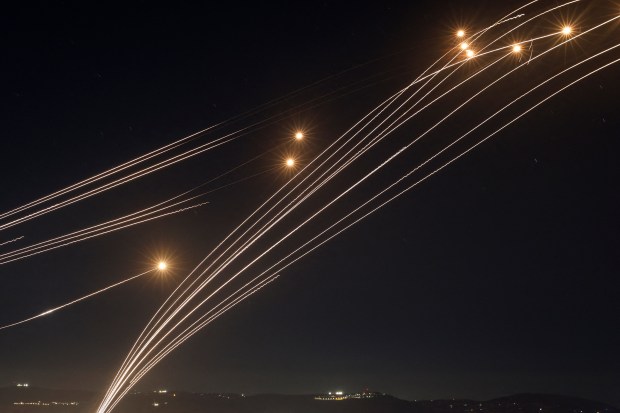AS rockets rain down on Israel day after day Technical Sergeant Y and her team have just seconds to act.
Operating the Iron Dome is an extraordinary task, with millions of lives lying in the hands of teams across the country working around the clock to fend off relentless attacks.
Developed out of necessity and honed by the consistent threat of bombardment from Gaza, Lebanon and Iran, the Iron Dome is nothing short of a technological marvel.
Its battery systems intercept short-range rockets as well as shells and mortars at ranges of between 2.5 and 40 miles – with a formidably high success rate.
In fact, an IDF commander in Israel‘s south last week told me it’s as high as 96 per cent.
With the Middle East again teetering on the precipice of World War Three as tensions with Iran and Hamas flare, Israel’s “missile shield” is more vital now than ever.
Hidden at a secret location in the north, Technical Sergeant Y defends her country from strikes unleashed from Iran, Hezbollah in Lebanon and Syria.
“Whatever comes we’re ready for it,” the officer, whose identity The Sun is protecting, warns.
“It doesn’t matter if it’s one rocket or 1,000 rockets – I will shoot every single one down.”
The Sun was given extraordinary rare access to the weapons system – with TSgt Y walking us through the agonising split-second life or death decisions every highly trained operator has to make.
She estimates she has blasted hundreds of rockets – knowing any one of them could fall on her loved ones.
Perhaps Israel’s greatest threat at the moment comes from Iran – described as the “head of the snake” by one Israeli politician in Jerusalem.
Senior political, diplomatic and military sources in Israel told me how they and the US are preparing to strike Iran in a bid to stamp out the threat posed by the country’s nuclear weapons programme.
Tehran would no doubt launch a devastating retaliation, which could look something like its almighty 300-strong missile and drone barrage a year ago.
Iron Dome operators are not waiting in trepidation, however, as they have every faith in the system which is “constantly updated”.
“Fearful [of an attack from Iran]? No.” Tsgt Y asserts.
“We’re prepared for anything that might come at the end of the day.
“We have dealt with attacks from Iran before. We know how to deal with it again.
“We’re always on alert, we always have backups and we’re 200 per cent prepared at all times.”
Since Hamas swept across the Gaza border on October 7, 2023 massacring hundreds and taking more than 250 hostages, Israel has come under fire from several terror groups.
“It’s obviously extremely upsetting. This is my home. This is my family, my friends. It’s a threat on my friend’s lives,” Tsgt Y admits.
“I have friends that live in the places that I am defending.
“Knowing that they are running to bunkers every single time that there’s an alarm, there’s a siren, as well as old people, as well as young children having to deal with it – it’s very, very traumatising to have to know, to have to deal with that.
“It’s very emotional for me because it is my family and it is my friends and it’s my home.
“But I know that I’m doing everything that I can to defend them and to make sure that they get home safe every single day and that they stay safe when they’re at their homes.”
The Sun’s visit to an Iron Dome battery

By Katie Davis, Chief Foreign Reporter (Digital)
THE Sun last week got a rare look at an Iron Dome battery system in southern Israel.
Tucked along a track away from prying eyes close to a city of around 33,000, a group of highly trained IDF soldiers work tirelessly to repel missiles fired by Hamas from Gaza.
Fenced off from the public, the batteries sit on a concrete base ready to be put into action at the drop of a hat.
Firing units are primed and ready to go, with the launchers always pointing towards the sky as incoming threats can come at any moment.
An IDF commander walked us through exactly how the remarkable system works and proudly told how they had successfully wiped out around 96 per cent of missiles fired their way.
Developed by Rafael Advanced Defense Systems and Israel Aerospace Industries, this exceptional kit is essential to Israel’s defence.
During my time in Israel last week, I saw first hand the devastation Hamas caused on October 7.
Kibbutz Nir Oz was decimated by callous terrorists and around a quarter of its residents were either brutally killed or taken hostage.
Hamas also unleashed a barrage of more than 5,000 missiles against Israeli targets that day in a bid to overwhelm its robust defence system.
Since then, the terror group has continued to repeatedly blitz Israel – but thanks to systems like the Iron Dome it has managed to limit casualty numbers.
During our interview, Tsgt Y is quick to dispel rumours the Iron Dome system is automated.
Every battery system across Israel has three or three launchers, each with 20 Tamir missiles.
While a radar system detects rocket threats and tracks them as a control system estimates the impact point, it is IDF soldiers who have just moments to make the crucial decision whether to intercept.
If a missile is heading towards an empty field, for example, the two-second verdict may be to let it fall rather than blow it up mid-air.
Tsgt Y said: “It’s a group of people making a decision.
“We are there and we are defending and we are sitting there 24/7 without a second off, making sure that everybody is safe.
“Because there are rumors [it is] automatic.
“There are people there, giving 100 per cent, staying awake during the latest hours and earliest mornings to make sure that everybody stays safe and goes home safe and sleeps soundly at night.”
But this sort of state-of-the-art defence doesn’t come cheap.
An IDF commander at a battery system close to a southern city told The Sun how just one interception rocket costs $10,000 (£7,700).
In some cases, it takes more than one to wipe out an incoming missile – escalating the bill greatly.
“Hamas know we have the Iron Dome so they try to overwhelm it by sending more rockets,” the commander added.
Since its deployment in 2011 – and certainly since October 7, 2023 – the Iron Dome has stopped thousands of missiles fired by Hamas and other terror groups.
Tsgt Y estimates she personally has shot down into the hundreds of missiles moments away from crashing into civilians in the year she has helped operate the robust mechanism.
As well as quite rightly feeling proud for defending her country, the gunner admits her job comes with a huge level of stress.
“You do have to make decisions, but we’re trained to know how to deal with that,” she says.
“And you kind of have to keep it cool. You have a lot of decisions that you learn to make, but we have the best training that there is.
“And at some point, you kind of just get used to it. You’re like you turn into a sort of machine and you work really, really hard.
“There have been stressful moments, but overall you learn to push through it and go through it and you get the training that’s needed.”
Like all things in life, the Iron Dome remains a learning curve and is constantly being upgraded, “like an iOS update on your iPhone”, Tsgt Y tells me.
She adds: “Whenever we see that there are issues or even if we see that we can do things better, we will always strive to do things better.
“When the war started, we didn’t really have a lot of action when it came to even UAVs. We didn’t really have them in the field.
“And because of the war we learned to upgrade our system and get better at it and learn how to make it as good as possible even for that.
“We’ve seen amazing improvements from the beginning of the war to where we are now. And we’re continuing to improve every single day.”
Despite its capabilities, envied by endless countries and the likes of Donald Trump, the battery systems remain mobile.
The IDF commander told me: “They can pack up this whole base in three hours and put it on a truck if they need reinforcement elsewhere.”
Rather than one say eight or nine-hour shift, Tsgt Y and her teammates only work short stints at a time to ensure they stay focussed.
She adds: “I can go on shift a couple times a day, but there’ll always, always be someone there. It’ll never, ever, ever stand alone.
“We’ll always have people sitting and making sure that they’re defended and that the country is defended.
How Israel’s defence mechanisms work
Iron Dome
The Iron Dome is Israel’s most famed missile shield.
It intercepts short-range rockets as well as shells and mortar.
Iron Dome batteries are scattered across Israel, with each base having three or four launchers.
Each launcher has 20 interceptor missiles.
A radar system detects rockets and calculates the trajectory, while a control system estimates the impact point.
An operator then decides whether to launch rockets to intercept.
David’s Sling
David’s Sling destroys longer-range rockets, cruise missiles and medium or long-range ballistic missiles.
It started operation in 2017 and like the Dome, only stops missiles that threaten civilians and infrastructure.
Arrow 2 and Arrow 3
Arrow 2 wipes out short-range and medium-range ballistic missiles while they are flying through the upper atmosphere.
It is able to detect missiles up to 500km away.
Missiles from Arrow 2 can travel at nine times the speed of sounds – firing at up to 14 targets at once.
Arrow 3 meanwhile intercepts long-range ballistic missiles as they travel at the top of their arc outside the Earth’s atmosphere.
Thaad system
Thaad is a US-made system, designed to work in a similar way to David’s Sling and intercept missiles towards the end of their flight.
It can stop missiles inside and outside the Earth’s atmosphere.
Thaad batteries usually have six launchers, which each contain eight missiles.
“And it’s [the shifts are] a couple hours to make sure that we’re also as sharp as we can be and that we get our rest.”
Threats in northern Israel come principally from Lebanon and Iran, both supporters of Hamas.
Fears Iran could blitz Israel remain very real as Donald Trump has called for “bombing” if Tehran fails to reach a deal on its nuclear programme.
Last April, Tehran unleashed a huge blitz on Israel in a retaliatory strike for an attack on its Damascus consulate.
Sirens wailed as 300 missiles and drones fired towards Israel. But thanks to Israel’s near-perfect defence mechanisms, the damage was a lot more limited than would could have been.
Reflecting on the IDF’s success that day, Tsgt Y said: “It was very intense, unlike some things that we haven’t seen. But we dealt with it in an amazing success.
“Everyone was super sharp. It was one of the most proud moments, but also very realistic moments to understand the level of terror that we’re dealing with and understanding how much civilians are being attacked and how drastic it can get.
“And it puts you into perspective. At the end of the day, we were very proud and happy to see that we could deal with it and that we were so successful.
“But it’s very upsetting to see that this is the level that it has come to and that there are so many people staying hours and hours in bunkers because they don’t know what’s going to happen and they fear for their lives.”



















